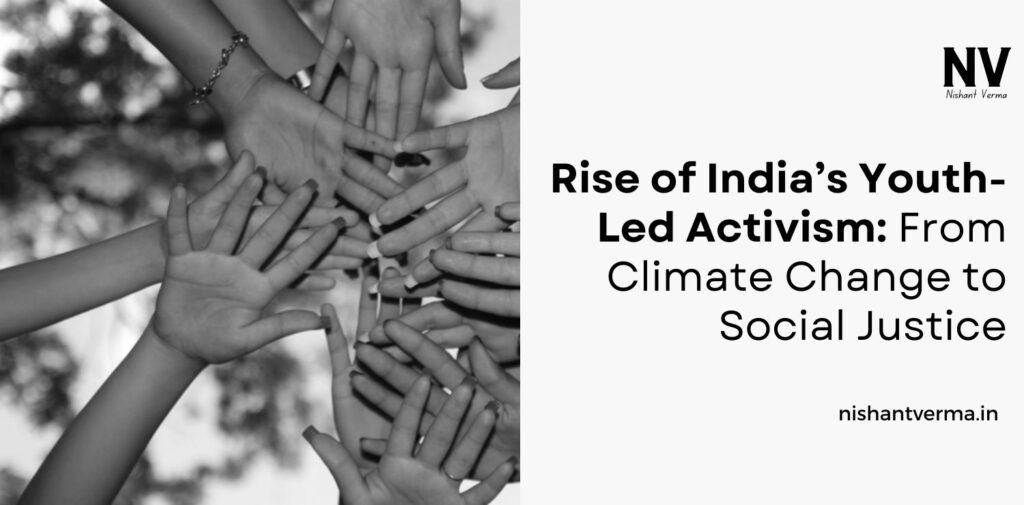India has long been a country with a rich history of activism and social movements, but in recent years, the country has witnessed a new wave of activism, driven largely by its youth. Today’s youth are using their voices and platforms to tackle pressing issues such as climate change, social justice, and inequality. This surge of youth-led activism is not only transforming India but also becoming a powerful force for change on the global stage. From school students to young professionals, the youth of India are increasingly challenging the status quo, speaking out on issues that matter to them, and pushing for a better future.
The Growing Influence of Youth Activism in India
Youth activism in India has always had a presence, but over the past two decades, it has seen a sharp rise. A combination of factors, including widespread access to social media, a more politically aware generation, and a growing sense of responsibility towards the environment and society, has led to this surge. Unlike earlier generations, today’s youth is more connected and aware of global issues, and they are taking action in ways that were unimaginable a few decades ago.
Social media platforms like Twitter, Instagram, and Facebook have played a crucial role in amplifying the voices of young activists. These platforms allow them to reach a wide audience, mobilize people for protests, and raise awareness about important issues. Young people today are not just passive consumers of information; they are active participants in global conversations on climate change, inequality, and human rights.

The Fight Against Climate Change: Young Voices Leading the Charge
One of the most powerful movements driven by India’s youth is the fight against climate change. Over the past few years, young activists have taken the lead in demanding urgent action to protect the environment. Greta Thunberg’s global “Fridays for Future” movement, which calls for action on climate change, has inspired many young Indians to join the cause. In cities across India, students and young professionals have organized protests, rallies, and campaigns to raise awareness about the climate crisis.
Young activists in India are particularly concerned about the impact of climate change on their future. From rising temperatures and erratic weather patterns to pollution and deforestation, the youth of India are feeling the consequences of environmental degradation. They are calling for more sustainable policies, stricter environmental regulations, and greater investment in renewable energy. Many youth-led organizations and student groups are working on local projects to combat pollution, conserve water, and promote eco-friendly practices.
A notable example of youth activism on climate change is the work of the Indian Youth Climate Network (IYCN), which has mobilized young people across the country to take action on climate issues. The network organizes events, campaigns, and advocacy initiatives to highlight the urgent need for climate action. The youth are pushing for both government and private sector accountability and are demanding a commitment to reducing carbon emissions and preserving natural resources for future generations.
Social Justice and Equality: Youth Advocates for Change
Apart from climate change, India’s youth have also become strong advocates for social justice and equality. Whether it is fighting for women’s rights, LGBTQ+ rights, or the rights of marginalized communities, young people are increasingly speaking out against discrimination and injustice. They are using their voices to highlight issues of caste, gender, and economic inequality and to push for a more inclusive society.
One significant area where youth activism has gained momentum is the fight for women’s rights. Following high-profile cases of sexual violence, young activists have taken to the streets to demand stronger laws, better enforcement, and social change. Movements like the #MeToo movement in India saw young people, especially women, speak out against harassment and discrimination in the workplace and at educational institutions.
Youth-led organizations such as the ‘Beti Bachao Beti Padhao’ campaign and ‘Young Women for Change’ have been instrumental in promoting gender equality. These groups are not just focused on raising awareness but are actively working on grassroots initiatives to empower young girls and women through education, healthcare, and financial independence. The youth are also advocating for a stronger legal framework to protect women from violence and discrimination.
Another major focus of youth activism has been the fight for the rights of marginalized communities, including Dalits, Adivasis, and Muslims. India’s caste-based discrimination has been a long-standing issue, and young people are challenging this deeply ingrained system. Many youth activists are organizing protests, awareness campaigns, and social media initiatives to expose caste-based violence and discrimination. They are also demanding affirmative action and greater opportunities for marginalized groups in education, employment, and political representation.

The Role of Technology and Social Media in Empowering Youth Movements
One of the most significant factors contributing to the rise of youth-led activism in India is the use of technology and social media. In today’s digital age, young people have access to vast amounts of information and are able to communicate instantly with others across the world. Social media platforms have become powerful tools for mobilization, advocacy, and organizing protests.
Hashtags like #ClimateStrike, #SaveOurPlanet, and #WomenForChange have gained traction, with young activists using them to spread their message and build a global movement. Youth are also using social media to share stories, organize petitions, and raise funds for social causes. Campaigns that would have once been limited to local communities now have the potential to go viral and reach audiences globally.
The use of online platforms also allows young people to bypass traditional media channels, which can sometimes be slow or reluctant to cover grassroots movements. With the rise of citizen journalism, young activists are taking control of their narratives and ensuring that their issues are heard. Social media also helps to create a sense of solidarity, as young activists from different parts of the country can connect, collaborate, and support one another.

Youth-Led Movements in India: Challenges and the Road Ahead
While youth activism in India has gained significant momentum, it has not been without its challenges. One of the major hurdles faced by young activists is the resistance from political leaders, the establishment, and sometimes even the public. Many young activists have faced harassment, threats, and violence for speaking out on sensitive issues. In some cases, activists have been accused of being anti-national or unpatriotic for criticizing government policies.
Furthermore, while youth activism is growing, it is still limited to a relatively small section of society. The majority of young people in India, especially in rural areas, do not have the resources or access to technology to engage in activism. Bridging this gap and ensuring that all young people have the opportunity to participate in social change is an ongoing challenge.
Despite these challenges, the rise of India youth-led activism is a positive sign for the future. It shows that young people are increasingly aware of the issues affecting their society and are determined to make a difference. Whether it is fighting for climate action, gender equality, or social justice, the youth of India are leading the charge for change. The road ahead may be difficult, but the passion and commitment of India’s youth will undoubtedly shape the country’s future in meaningful ways.
Conclusion: India Youth-Led Activism
India youth-led activism is a testament to the power of young people in shaping society and driving social change. In the post-2000 era, youth activism in India has moved beyond traditional forms of protest and has become a dynamic force for progress. From fighting climate change to advocating for social justice, the youth of India are showing the world that they are ready to take on the challenges of the 21st century.
With the help of technology, social media, and an unwavering sense of justice, young people in India are leading movements that challenge the status quo and demand a better future. As these movements continue to grow, they will likely play an even more prominent role in shaping India’s political and social landscape. The rise of youth-led activism in India is not just a passing trend—it is the beginning of a new era of social change, led by the next generation of leaders, thinkers, and changemakers.




